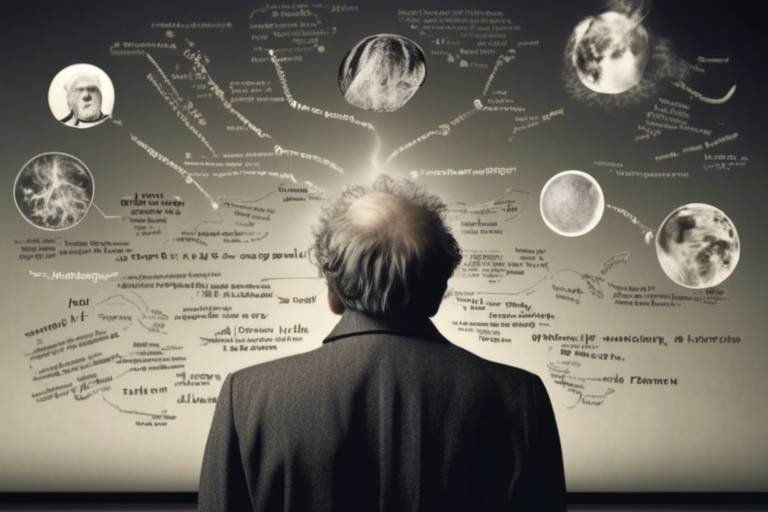Holographic Principle - The Interplay of Physics and Philosophy
The concept of the holographic principle is nothing short of mind-bending. Imagine for a moment that everything you perceive—your surroundings, the universe, even your own existence—might just be a projection. This idea, which merges the realms of physics and philosophy, suggests that our three-dimensional reality could be encoded on a distant two-dimensional surface. It's like watching a movie where the entire plot is cleverly condensed into a single frame, yet it feels so rich and detailed. But how does this work? And what does it mean for our understanding of reality?
At its core, the holographic principle posits that all the information contained in a given volume of space can be represented as a hologram on its boundary. This revolutionary idea has sparked a profound curiosity among scientists and philosophers alike, leading to a reevaluation of our fundamental understanding of the universe. It's as if we're peering through a keyhole into a vast landscape that we thought we knew, only to discover that there are layers upon layers of complexity hidden from our view.
As we delve deeper into this concept, we find ourselves standing at the intersection of science and philosophy. The implications are staggering—could it be that our perceptions are merely illusions? Just as a magician might pull a rabbit from a hat, the holographic principle challenges us to reconsider what we accept as reality. Are we merely observers in a grand cosmic performance, or is there something more? This question not only ignites our imagination but also compels us to explore the very essence of existence.
In exploring the holographic principle, we embark on a journey that takes us through the annals of modern physics, challenging our perceptions and pushing the boundaries of our understanding. It’s a fascinating interplay of information, space, and consciousness that invites us to ponder our place in the universe. So, let’s unravel this enigma together, as we explore the origins, implications, and applications of the holographic principle.
- What is the holographic principle? The holographic principle suggests that all the information in a volume of space can be represented as a hologram on its boundary, implying that our three-dimensional reality may be an illusion.
- How does this relate to black holes? The principle originated from black hole physics, where it was proposed that information swallowed by black holes is not lost but stored on their event horizons.
- What are the philosophical implications? The holographic principle challenges our understanding of existence and reality, inviting philosophical inquiry into the nature of consciousness and the universe.
- How does it affect modern physics? It has influenced fields such as string theory and quantum gravity, providing new perspectives on the fundamental nature of space, time, and matter.

Understanding the Holographic Principle
The holographic principle is a mind-bending concept that suggests our entire universe, with all its complexities, might just be a projection of information stored on a distant surface. Imagine for a moment that everything you see, feel, and experience is merely a three-dimensional illusion crafted from two-dimensional data. This idea challenges our fundamental understanding of reality, pushing the boundaries of both physics and philosophy.
At its core, the holographic principle proposes that the information contained within a given volume of space can be encoded on a two-dimensional boundary that surrounds it. Think of it as a hologram: a three-dimensional image created from a two-dimensional surface. This perspective not only alters our conception of space but also raises profound questions about the nature of existence itself. If reality is just a projection, what does that say about our perceptions and the universe we inhabit?
To grasp this concept, we can draw parallels with technology we encounter every day. Consider how a computer can simulate a vast, intricate world on a flat screen. The data that makes up this virtual environment is stored in a two-dimensional format, yet it creates the illusion of depth and complexity. Similarly, the holographic principle suggests that our universe might be a grand simulation, where the fundamental properties of space and time are derived from simpler, underlying information.
One of the most intriguing aspects of the holographic principle is its implications for our understanding of black holes. According to this theory, when matter falls into a black hole, the information it carries is not lost but rather preserved on the black hole's event horizon. This revelation leads to the tantalizing idea that the universe itself might be a cosmic hologram, with every particle of information contributing to the grand tapestry of existence.
As we delve deeper into this fascinating concept, it's essential to recognize that the holographic principle is not just a theoretical exercise; it has real-world applications in modern physics, offering insights into the fundamental nature of reality. The implications stretch across various fields, including string theory and quantum gravity, providing a framework for understanding how the universe operates at its most fundamental levels.
In summary, the holographic principle invites us to reconsider everything we thought we knew about reality. It challenges our perceptions and encourages us to explore the interplay between information and existence. As we continue to unravel the mysteries of the universe, this principle may hold the key to understanding not just the cosmos, but our place within it.

Origins of the Concept
The origins of the holographic principle are as fascinating as the concept itself. It all began with the enigmatic realms of black hole physics. Imagine a cosmic vacuum cleaner, sucking in everything that comes too close—light, matter, even information. But here's the kicker: what happens to all that information? This question sparked a philosophical and scientific debate that has intrigued physicists for decades.
In the 1970s, physicist Stephen Hawking made a groundbreaking revelation regarding black holes: they emit radiation, which is now famously known as Hawking radiation. This discovery led to a profound implication: if black holes can radiate energy, then they must also have a way of encoding the information they consume. This idea challenged the long-held belief that information swallowed by black holes is lost forever, igniting what is known as the information paradox.
Building on Hawking's work, another physicist, Leonard Susskind, proposed that the information is not lost but rather stored on the event horizon—the boundary surrounding a black hole. This concept likened the event horizon to a holographic plate that contains all the information about the three-dimensional objects that have fallen into the black hole. Essentially, everything that enters a black hole is encoded on this two-dimensional surface, suggesting that our perception of three-dimensional reality may merely be a projection of this encoded information.
To put it simply, think of a hologram. When you look at a holographic image, you see a three-dimensional object, but it is actually just a pattern encoded on a two-dimensional surface. The holographic principle suggests that our universe may function in a similar way, where all the information about our three-dimensional reality is encoded on a distant two-dimensional surface. This revolutionary idea not only reshapes our understanding of black holes but also invites us to reconsider the very fabric of reality itself.
Moreover, the implications of this principle extend far beyond black holes. It raises profound questions about the nature of space and time, leading to a deeper inquiry into the fundamental workings of the universe. As physicists continue to explore these ideas, they find themselves at the intersection of physics and philosophy, contemplating not just how the universe works, but also what it means to exist within it.
In summary, the origins of the holographic principle lie in the quest to understand black holes and the nature of information. As we delve deeper into this concept, we uncover layers of complexity that challenge our perceptions and invite us to rethink the very essence of reality.

Black Holes and Information Paradox
The concept of black holes has long fascinated both scientists and the general public alike. Imagine a region in space where gravity is so strong that nothing, not even light, can escape its pull. This intriguing phenomenon leads us directly into the heart of the information paradox, a conundrum that challenges our fundamental understanding of physics. You might be wondering, how can something so powerful possibly lead to the loss of information? The answer lies in the clash between general relativity and quantum mechanics.
The information paradox arises when we consider what happens to the information about the matter that falls into a black hole. According to classical physics, once something crosses the event horizon—the point of no return—it seems that all information about its state is lost forever. This notion is troubling because it contradicts a key principle of quantum mechanics: information cannot be destroyed. So, what gives?
To illustrate this paradox, let’s use an analogy. Think of a black hole as a cosmic vacuum cleaner. When you suck something up, it seems to vanish into thin air. However, if you were to open the vacuum cleaner later, you would expect to find the contents inside, right? In the case of black holes, if we can’t retrieve the information, it’s as if the vacuum cleaner has a magical ability to obliterate everything it consumes, leaving us with a huge question mark.
Several prominent physicists, including Stephen Hawking and Leonard Susskind, have explored this paradox extensively. Hawking proposed that black holes emit radiation—a phenomenon known as Hawking radiation—which could potentially carry information away from the black hole. However, this leads to another dilemma: if the radiation carries information, does that mean the information was never truly lost, or is it merely transformed?
To further complicate matters, Susskind's theory suggests that information is not lost but rather encoded on the surface of the black hole, much like a hologram. This idea aligns perfectly with the holographic principle, which posits that all the information contained in a volume of space can be represented on its boundary. In this sense, the surface of a black hole could be viewed as a two-dimensional representation of the three-dimensional reality we experience. The implications of this are profound, as they challenge our conventional understanding of space and time.
In summary, the black hole information paradox serves as a critical junction where physics and philosophy intersect. It forces us to rethink our definitions of reality, existence, and the very fabric of the universe. As we delve deeper into the mysteries of black holes, we may find that the answers not only reshape our understanding of the cosmos but also reflect on the nature of our own consciousness and the reality we perceive.
- What is the information paradox? The information paradox refers to the question of whether information that falls into a black hole is lost forever or can be recovered.
- Who proposed the idea of Hawking radiation? Stephen Hawking proposed the concept of Hawking radiation, suggesting that black holes can emit radiation and potentially leak information.
- What does the holographic principle state? The holographic principle suggests that all the information contained in a volume of space can be represented as a hologram on a two-dimensional surface.

Key Theories Explored
The exploration of the holographic principle has led to a fascinating intersection of ideas from some of the greatest minds in physics. One of the most prominent figures in this discussion is Stephen Hawking, who initially proposed that black holes emit radiation, now famously known as Hawking radiation. This concept raised the question of whether information that falls into a black hole could ever be retrieved, igniting a debate that continues to this day. Hawking's work suggested that while matter might be lost, the information itself could be encoded on the event horizon, the boundary surrounding a black hole.
Another key player in this arena is Leonard Susskind, who countered Hawking's views by asserting that information is never truly lost. Susskind introduced the idea of the holographic principle as a way to reconcile the apparent contradictions between quantum mechanics and general relativity. He argued that the information contained within a volume of space can be represented on its boundary, similar to how a hologram encodes three-dimensional images in two dimensions. This idea fundamentally challenges our conventional understanding of space and reality.
Moreover, the work of Juan Maldacena cannot be overlooked, as he provided a concrete example of the holographic principle through his AdS/CFT correspondence. This theory posits a relationship between a gravitational theory in a higher-dimensional space (Anti-de Sitter space) and a conformal field theory defined on its boundary. This correspondence has opened up new avenues for understanding quantum gravity and has implications for string theory as well.
To summarize the key theories explored in relation to the holographic principle, consider the following table:
| Physicist | Theory/Contribution |
|---|---|
| Stephen Hawking | Proposed Hawking radiation; raised questions about information loss in black holes. |
| Leonard Susskind | Argued that information is never lost; introduced the holographic principle. |
| Juan Maldacena | Developed AdS/CFT correspondence, linking gravitational theories and quantum field theories. |
These theories not only deepen our understanding of black holes but also challenge our perceptions of reality itself. They prompt us to consider whether our experiences in the three-dimensional world are merely projections of a more complex, underlying reality. As we continue to dissect these theories, the implications stretch beyond physics, inviting us to ponder the very fabric of existence.

Implications for Quantum Mechanics
The holographic principle isn't just a mind-bending concept; it has profound implications for our understanding of quantum mechanics. Imagine for a moment that everything you perceive—every color, every sound, every sensation—is merely a projection of information encoded in a two-dimensional format. This idea challenges the very fabric of how we perceive reality. It suggests that our three-dimensional world is not the ultimate reality, but rather a complex illusion shaped by the underlying data that exists on a distant surface. This notion can be as bewildering as trying to grasp the vastness of the universe while standing in your living room.
One of the most intriguing aspects of this principle is how it aligns with the principles of quantum entanglement. In quantum mechanics, particles can become entangled, meaning the state of one particle is instantly connected to the state of another, no matter the distance between them. If we apply the holographic principle, it raises the question: could these entangled particles be manifestations of the same underlying information? This could mean that our understanding of space and locality is fundamentally flawed, as distance may be an illusion created by the way we interpret the holographic data.
Additionally, the holographic principle suggests a new way of looking at black holes. Traditionally, we view black holes as cosmic vacuum cleaners, sucking up everything in their vicinity, including light. However, if the information that falls into a black hole is preserved and encoded on its event horizon, it could lead to a revolutionary understanding of how information is treated in the universe. This perspective not only addresses the infamous information paradox but also implies that the universe itself may be a vast, interconnected web of information, where every particle and wave is a part of a grand tapestry.
To better understand these concepts, let's break down some key implications:
- Reality as Information: The idea that our three-dimensional reality could be a projection of two-dimensional information fundamentally alters our approach to physics. It invites us to rethink the nature of existence itself.
- Quantum Gravity: The holographic principle could provide a pathway to unify quantum mechanics and general relativity, two pillars of physics that have long been at odds. This unification could lead to a comprehensive theory of quantum gravity.
- New Models of Space-Time: If space and time are emergent properties of a deeper reality, our current models might need a complete overhaul. This could lead to new theories that better explain the behavior of particles at the quantum level.
Ultimately, the implications of the holographic principle for quantum mechanics are both exciting and daunting. They challenge our perceptions and invite us to explore a reality that is far more complex than we ever imagined. As we delve deeper into the mysteries of the universe, we may find that the answers lie not in the three dimensions we inhabit, but in the rich, intricate tapestry of information that underpins it all.
- What is the holographic principle?
The holographic principle suggests that all the information in a volume of space can be represented as a hologram on a two-dimensional surface, challenging our understanding of reality. - How does the holographic principle relate to black holes?
It implies that the information that falls into black holes is not lost but is instead encoded on their event horizons, leading to new insights into the nature of information in the universe. - Can the holographic principle unify quantum mechanics and general relativity?
Yes, it offers a potential framework for unifying these two fundamental theories, which have traditionally been at odds with each other.

Philosophical Implications
The holographic principle opens a fascinating gateway into the realm of philosophy, challenging our deepest assumptions about reality, existence, and consciousness. Imagine for a moment that everything you perceive—the vibrant colors of a sunset, the warmth of a loved one's embrace, or even the complexities of your thoughts—are mere projections of information encoded on a distant surface. This idea can be as bewildering as it is profound, prompting us to ask: What does it mean to exist in a universe that may be fundamentally different from our perceptions?
At its core, the holographic principle suggests that our three-dimensional experience is a sort of illusion, shaped and influenced by two-dimensional data. This notion invites us to reconsider the nature of reality itself. Are we merely observers in a grand cosmic play, where the stage is set by fundamental information? Or do we possess a deeper connection to the universe that transcends these projections? Such questions push the boundaries of philosophical inquiry, urging us to explore concepts like consciousness and our place within the cosmos.
Moreover, the implications of this principle extend beyond mere abstraction. They invite us to reflect on the nature of knowledge and understanding. If reality is a hologram, then our quest for knowledge may be akin to peeling back layers of a complex illusion, revealing deeper truths hidden beneath the surface. This leads to a fascinating intersection of science and philosophy, where the insights from quantum mechanics and cosmology intersect with age-old philosophical questions about existence and perception.
Consider how various philosophical schools of thought might interpret the holographic principle:
- Idealism: This perspective posits that reality is mentally constructed. The holographic principle could reinforce the idea that our perceptions shape reality, suggesting that the universe is a projection of consciousness.
- Realism: In contrast, realism asserts that an objective reality exists independent of our perceptions. The holographic principle challenges this notion, as it implies that our understanding of reality is limited and perhaps fundamentally flawed.
- Existentialism: Existentialists might find the holographic principle liberating, as it emphasizes individual experience and perception. If reality is a projection, then our subjective experiences become even more significant.
As we delve deeper into these philosophical implications, we find ourselves at the crossroads of science and existential inquiry. The holographic principle not only reshapes our understanding of the universe but also compels us to confront our own existence and consciousness. Are we simply observers of a grand illusion, or do we play an integral role in shaping the very fabric of reality? These questions remain at the forefront of philosophical discourse, igniting debates that bridge the gap between physics and the human experience.
- What is the holographic principle?
The holographic principle is a theory suggesting that all the information contained in a three-dimensional space can be represented as a two-dimensional hologram. - How does the holographic principle relate to black holes?
The principle emerged from black hole physics, where it was proposed that information absorbed by black holes is not lost but rather encoded on their event horizons. - What are the philosophical implications of the holographic principle?
The principle challenges our understanding of reality, existence, and consciousness, suggesting that our perceptions might be mere projections of a deeper, underlying reality.

Applications in Modern Physics
The holographic principle is not just a mind-bending concept; it has profound implications across various fields of modern physics. Imagine if our understanding of the universe could be flipped on its head, where the very fabric of reality is woven from two-dimensional threads. This is precisely what the holographic principle suggests, and its applications are as fascinating as they are complex. One of the most significant areas influenced by this principle is string theory, which posits that the fundamental constituents of matter are not point-like particles but rather tiny, vibrating strings. The holographic principle provides a framework that helps physicists visualize and understand how these strings interact in a higher-dimensional universe.
Additionally, the holographic principle sheds light on the mysteries of quantum gravity. Traditional theories have struggled to reconcile general relativity with quantum mechanics, but by applying holographic ideas, researchers are forging new pathways to unify these two pillars of physics. For instance, the AdS/CFT correspondence—a key result in theoretical physics—illustrates how a gravitational theory in a higher-dimensional space (Anti-de Sitter space) corresponds to a conformal field theory on its boundary. This correspondence not only enriches our understanding of gravity but also opens up exciting avenues for exploring the quantum aspects of black holes.
Furthermore, the holographic principle offers insights into the early universe. During the period of cosmic inflation, the universe expanded exponentially, and the holographic perspective provides a theoretical backdrop for understanding the uniformity we observe today in the cosmic microwave background radiation. By considering the universe as a hologram, scientists can better comprehend the mechanisms behind the smoothness and isotropy of space, leading to a deeper understanding of cosmic evolution.
To illustrate the diverse applications of the holographic principle, consider the following table that summarizes its key implications in modern physics:
| Field | Application | Impact |
|---|---|---|
| String Theory | Framework for understanding interactions of fundamental strings | Unifies various physical theories under a single framework |
| Quantum Gravity | AdS/CFT correspondence | Enhances understanding of gravitational theories and black holes |
| Cosmology | Theoretical backdrop for cosmic inflation | Provides insights into the early universe and cosmic structure |
In summary, the holographic principle is not merely a theoretical curiosity but a vital tool that is reshaping our understanding of the universe. By bridging gaps between disparate fields and offering fresh perspectives on complex problems, it serves as a reminder that our grasp of reality is continually evolving. As physicists delve deeper into these applications, who knows what other astonishing revelations await us?
- What is the holographic principle?
The holographic principle suggests that all the information in a volume of space can be encoded on a two-dimensional surface, implying that our three-dimensional reality may be an illusion. - How does the holographic principle relate to black holes?
The principle originated from black hole physics, where it was proposed that information swallowed by black holes is not lost but instead stored on their event horizons. - What are the implications of the holographic principle for quantum mechanics?
It raises questions about the nature of reality, suggesting that our perceptions may be shaped by underlying two-dimensional information. - Can the holographic principle be tested?
While direct experimental verification is challenging, researchers are exploring its implications through mathematical models and indirect observations in cosmology and particle physics.

String Theory and Holography
The relationship between string theory and the holographic principle is a fascinating intersection that opens up a universe of possibilities in our understanding of reality. At its core, string theory posits that the fundamental building blocks of the universe are not point-like particles, but rather one-dimensional strings. These strings vibrate at different frequencies, and their vibrations determine the properties of the particles we observe. This concept challenges our classical notions of particles and invites us to think of the universe in a more dynamic and interconnected way.
Now, how does this tie into the holographic principle? Imagine if the entire universe is akin to a hologram—a 3D image created from a 2D surface. The holographic principle suggests that all the information about the three-dimensional space we inhabit can actually be encoded on a two-dimensional boundary. This means that, in some sense, our reality might be a projection of information stored at a distant surface, much like how a hologram is a projection of light that creates an image. This idea can be quite mind-bending, as it challenges our perception of space and dimension.
To better understand this relationship, consider the following points:
- Dimensionality: In string theory, the universe may have more dimensions than the three we can perceive. The holographic principle helps us conceptualize how these additional dimensions might interact with our familiar three-dimensional space.
- Quantum Gravity: String theory aims to unify quantum mechanics and general relativity, and the holographic principle provides a framework for understanding how gravity operates at quantum scales.
- Information Preservation: Both concepts emphasize the importance of information in the universe, suggesting that information is never truly lost, even in extreme conditions like black holes.
In a more technical sense, the holographic principle is often illustrated through the AdS/CFT correspondence, a conjecture that connects a gravitational theory in an Anti-de Sitter space (AdS) with a conformal field theory (CFT) on its boundary. This correspondence exemplifies how a higher-dimensional theory can be described by a lower-dimensional one, reinforcing the idea that our universe might be a projection of a more fundamental reality.
As we delve deeper into the implications of string theory and holography, we begin to see a potential shift in our understanding of the universe. It raises profound questions about the nature of existence itself. Are we merely observers in a grand cosmic illusion? Or is there a deeper truth waiting to be uncovered? These inquiries not only fuel scientific exploration but also inspire philosophical reflection on the essence of reality and our place within it.
In summary, the interplay between string theory and the holographic principle is a captivating area of study that continues to challenge our understanding of the universe. By exploring these concepts, we not only expand our knowledge of physics but also open the door to new philosophical inquiries that may redefine our perception of existence.

Cosmological Insights
The holographic principle not only reshapes our understanding of black holes but also provides fascinating insights into the cosmos itself. Imagine the universe as a grand stage, where every star, planet, and galaxy is part of a spectacular show, yet the script is written on a distant, invisible surface. This metaphor captures how the holographic principle suggests that the universe's vast complexities can be encoded in simpler, two-dimensional data. It opens up a treasure trove of possibilities, particularly regarding the early universe and cosmic inflation.
When we consider the early universe, the holographic principle helps to explain some of the mysteries surrounding cosmic inflation—a period of rapid expansion that occurred just after the Big Bang. During this time, the universe grew exponentially, and the uniformity observed in the cosmic microwave background radiation (CMB) can be interpreted through this lens. The CMB acts like the afterglow of the Big Bang, and its uniformity across vast distances suggests that all regions of the universe were once in close contact. The holographic principle posits that this contact may be encoded on a two-dimensional surface, leading to the uniformity seen today.
Moreover, the insights provided by the holographic principle extend to our understanding of the fundamental structure of space and time. It challenges the traditional view that space is merely a backdrop for events to unfold. Instead, it suggests that the very fabric of the universe is a dynamic interplay of information, much like a hologram where every part contains the whole. This perspective invites us to reconsider how we perceive distances and relationships between celestial bodies. The universe, in this sense, may not be a vast emptiness but rather a complex interplay of encoded information, continuously interacting and evolving.
To further illustrate the implications of the holographic principle in cosmology, let's take a look at the following table that summarizes key concepts:
| Concept | Description |
|---|---|
| Cosmic Inflation | A rapid expansion of the universe after the Big Bang, leading to uniformity in the CMB. |
| Cosmic Microwave Background (CMB) | The afterglow radiation from the Big Bang, providing insights into the early universe. |
| Two-Dimensional Encoding | The idea that all three-dimensional information may be represented on a two-dimensional surface. |
| Interconnectedness | The notion that distances and relationships in the universe are encoded information rather than mere physical separations. |
In summary, the holographic principle not only enhances our understanding of black holes but also enriches our comprehension of the universe's origins and structure. It encourages us to look beyond the surface of reality and consider the intricate web of information that shapes our cosmic existence. As we delve deeper into these cosmological insights, we find ourselves at the intersection of physics and philosophy, where the mysteries of the universe beckon us to explore further.
- What is the holographic principle? The holographic principle suggests that all the information in a volume of space can be represented as a hologram on a two-dimensional surface.
- How does this principle relate to black holes? It proposes that information swallowed by black holes is not lost but rather stored on their event horizons.
- What implications does it have for our understanding of reality? It challenges our perception of reality, suggesting that our three-dimensional experience may be an illusion shaped by two-dimensional information.
- Can the holographic principle explain the uniformity of the universe? Yes, it provides a framework to understand how the early universe's rapid expansion led to the uniformity observed in the cosmic microwave background.
Frequently Asked Questions
- What is the holographic principle?
The holographic principle is a fascinating idea in physics suggesting that all the information contained in a three-dimensional space can be represented as a two-dimensional hologram. Imagine a movie that, despite being projected on a flat screen, creates a vivid, three-dimensional experience—this is somewhat like how our universe might work under this principle!
- How did the concept of the holographic principle originate?
The roots of the holographic principle can be traced back to black hole physics. It was proposed that the information swallowed by black holes isn't lost forever; instead, it is stored on the event horizon, much like a hard drive that keeps all the files intact even when it's turned off. This idea challenges our traditional understanding of information and reality.
- What is the black hole information paradox?
The black hole information paradox raises a critical question: Is information truly lost when it falls into a black hole? This paradox has sparked intense debates among physicists, leading to groundbreaking theories that suggest information might be recoverable, thus reshaping our understanding of quantum mechanics.
- How does the holographic principle relate to quantum mechanics?
The holographic principle suggests that our three-dimensional reality might be an illusion created by two-dimensional information. Think of it like a video game where the graphics appear three-dimensional, but all the data is stored on a flat disk. This idea challenges our perceptions and invites us to reconsider the very nature of existence!
- What are the philosophical implications of the holographic principle?
This principle invites deep philosophical questions about reality, existence, and consciousness. If our understanding of the universe is merely a projection, what does that mean for our sense of self? It's like pondering whether we are the main characters in a story or just characters in someone else's narrative.
- How has the holographic principle influenced modern physics?
The holographic principle has had a significant impact on various fields, including string theory and quantum gravity. It provides a new lens through which we can view the fundamental nature of space, time, and matter, much like how a new perspective can change the way we interpret a piece of art.
- What is the connection between string theory and the holographic principle?
String theory posits that the basic building blocks of the universe are one-dimensional strings. The holographic principle helps us understand how these strings interact and the implications they have for higher dimensions, making it a crucial framework in modern theoretical physics.
- Can the holographic principle explain the early universe?
Yes! The holographic principle offers intriguing insights into the early universe, helping us understand phenomena like cosmic inflation and the uniformity observed in the cosmic microwave background radiation. It’s like having a cosmic map that reveals the underlying structure of our universe's history.



















